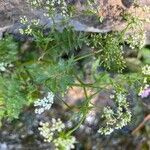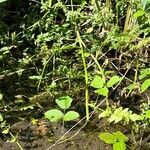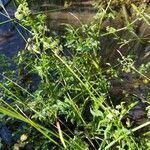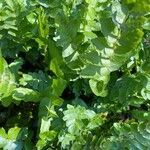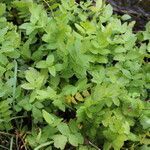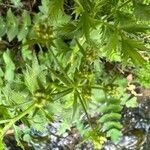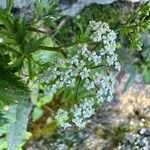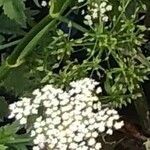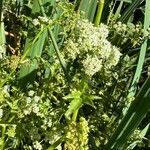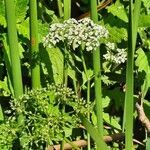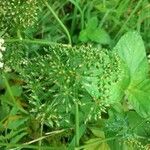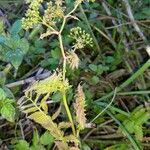Plants 40–50(–100) cm. Stem hollow, branched, rooting at basal nodes. Submerged leaves 3–4-pinnate; ultimate segments linear. Aerial leaves 1-pinnate; pinnae 4–9(–15) pairs, basal pairs remote, sessile, ovate-lanceolate or oblong, 1.5–5(–7) × 0.8–2.5(–3) cm, base obliquely truncate, usually with 1 lobe at basal edge, margins serrate or irregularly incised. Upper leaves smaller, sheaths expanded. Umbels 4–6 cm across; bracts 3–6, oblong or lanceolate, 6–21 mm, entire or incised; rays 5–15 (–20), 2–3 cm, unequal; bracteoles 5–8, 1.5–5 mm, unequal, usually entire, nearly as long as or longer than the pedicels; umbellules 10–20-flowered; pedicels 2–5 mm, unequal. Calyx teeth 0.4–0.8 mm. Fruit 2–2.2 × 1.5–2 mm. Fl. May–Jun, fr. Jul–Aug.
Leaves up to 50 cm. long, simply pinnate, with 7–12 pairs of sessile leaflets; petioles up to 12 cm. long, leaf bases narrowly sheathing. Leaflets 1–8 cm. long, coarsely and rather irregularly toothed (some of the lower leaflets sometimes showing a tendency towards the separation of leaflets of the second order). Teeth sometimes with a cartilaginous covering which may extend along the margin towards the next tooth. Upper leaves gradually reduced in size and form upwards.
Stem sparsely branched, to 8 dm; lvs oblong, the 9–23 lfls lanceolate to oblong or ovate, serrate or lobed, those of the upper lvs commonly lanceolate and deeply incised; rays 5–15, 1–3 cm; umbellets 1 cm wide; fr 1.5–2 mm, rarely maturing; 2n=12. Springs, bogs, and shallow water; N.Y. and s. Ont. to Minn. and B.C., s. to Fla. and Mex.; Europe and the Mediterranean region. June–Sept. The Amer. plants are var. incisa (Torr.) Cronquist. (B. pusilla)
Umbels terminal and lateral on peduncles 2–12 cm. long. Bracts numerous and well developed, narrowly linear with a narrow membranous margin or linear-3-partite with obvious lateral teeth. Rays often rather irregular, 10–20; bracteoles numerous, similar to the bracts but correspondingly smaller.
Fruit c. 2 mm. long, brownish at maturity, almost orbicular, slightly broader than long, depressed laterally; stylopodium 0·5 mm. long, small, conical; styles c. 1 mm. long, slightly clubbed at the apex; ribs filiform and inconspicuous at maturity.
A feather-like herb. It is a creeping plant. It grows 30 cm high. It keeps growing from year to year. The runners form roots in mud. The stems are hollow. The flowers are white and in small heads.
Robust glabrous perennial herb up to 2·5 m. high, erect or decumbent, rhizomatous to stoloniferous, rooting at the nodes.
Petals white, calyx teeth triangular-subulate, persistent in fruit.
Flowers on fine, sometimes irregular, pedicels.
Stem hollow, terete, with coarse grooves.
